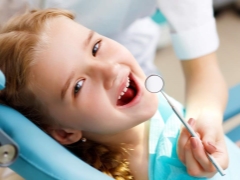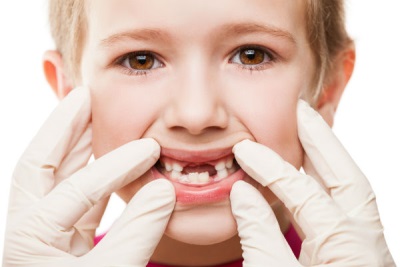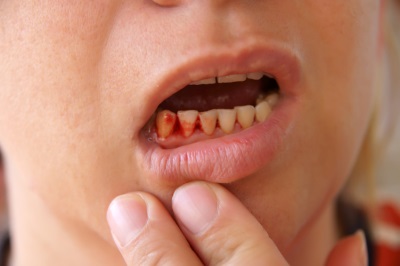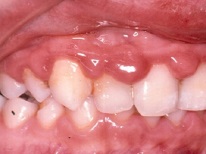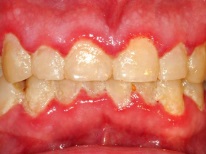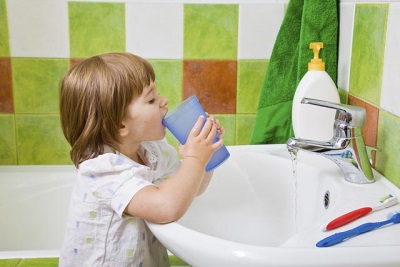Gingivitis - inflammation of the gums in a child
Inflammation of the gums, which is called gingivitis in medicine, is very common in childhood. In the acute stage, it is quite easily diagnosed due to the severe clinical picture, and chronic gingivitis is often detected during regular check-ups at the dentist. Any form of gingivitis in a child requires treatment, because the disease causes discomfort and can lead to serious problems with the oral cavity.
What is it
Gingivitis is a disease in which gum tissue adjacent to the teeth is affected. Most often, such inflammation occurs in children over five years old, especially in adolescence, but in 2% of cases, younger children can also get gingivitis, for example, at the age of 2 years or 3 years.
The reasons
The appearance of gum disease in a child is due to:
- Poor oral care, for example, if the child does not thoroughly clean the teeth or forgets to clean them. This is the main cause of gum disease in childhood.
- Injuriesin which the mucous membrane of the gums is damaged with the formation of cuts, burns or scratches. Especially often gum trauma occurs when teething baby teeth, when the baby tries to eliminate itching and gnaws various objects.
- Carieswho hit the milk teeth at 1 year old or older, as well as caries on permanent teeth.
- Incorrect bite or pathology of the lips or frenulum of the tongue, interfering with chewing.
- Molar eruption, if the child avoids pain and does not clear the problem area well enough.
- Poor quality fillings or use of orthodontic appliances.
- Disturbed nasal breathing due to which the child breathes through the mouth and mucous dries.
Provocative factors contributing to the weakening of local immunity and the occurrence of gingivitis are called:
- Infectious diseases.
- Allergy.
- Lack of vitamins in food.
- Diseases of the digestive tract (gallbladder, intestines).
- Diseases of the blood.
- Rheumatism.
- Diabetes.
- Tuberculosis.
- Hormonal dysfunction.
- Violation of metabolic processes.
- Kidney disease.
- Dysbacteriosis.
- Lack of saliva (this condition is called xerostomia).
- Too hard toothbrush.
- Irradiation.
Types and forms
Given the changes in the gums, gingivitis is divided into:
- Catarrhal. This is the most common variant of gum inflammation in children.
- Ulcerative. In this form, the child develops ulcerative lesions on the gums, and when the condition worsens, necrosis areas appear on them.
- Atrophic. With such gingivitis, the volume of gum tissue decreases.
- Hypertrophic. It appears due to chronic inflammation and represents the growth of gum tissue and their deformation.
Depending on the course of the disease is acute, which is manifested by severe symptoms, and chronicwhen the inflammatory process is mild, and pain is practically absent.
In terms of its localization, gingivitis can be localized if a small area between adjacent teeth is affected, as well as generalized if most of the gums are inflamed.
As for severity, gingivitis can happen:
- Easy - with this form, only the interdental papilla is affected.
- Moderately severe - the edge of the gums is affected.
- Heavy - inflammation covers not only the marginal, but also the alveolar part.
For more information on what it is and how gingivitis occurs, see the video:
Symptoms
In any form of gingivitis, the gums at the site of inflammation will be swollen and reddened, and plaque will be present on the teeth. Also, almost always the symptom of such an illness is bleeding of the gums under mechanical action, for example, while brushing your teeth or eating. Other signs of the disease depend on the stage of gingivitis.
Catarrhal gingivitis occurs:
- Sensation of itching and discomfort in the gums.
- Distortions of taste.
- Unpleasant smell from the mouth.
- Chemical or thermal sensations.
- A slight increase in temperature in the acute period.
Ulcerative gingivitis in addition to the symptoms inherent in catarrhal, is characterized by general intoxication, manifested by reduced appetite, poor sleep, malaise and whims.
The gums in this form of the disease are red with a slight blueness. In addition, looseness and thickening of the mucous membrane, as well as foci of erosion, are detected at the site of the lesion.
With an unfavorable course, such gingivitis becomes necrotic and manifests itself:
- Increased viscosity of saliva.
- The appearance of the smell of rot from the oral cavity.
- The formation of ulcers, on which there is a greenish-gray patina.
- Enlarged lymph nodes jaw.
With atrophic gingivitis, there will be no pronounced pain. The gums of the child will react to temperature irritants, and during the examination the doctor will notice on their surface dystrophic changes and bare teeth of the neck.
If gingivitis becomes hypertrophic, then it manifests itself:
- Child complaints of itching and pain in the gums.
- Bleeding gums when eating food.
- Chewing problems.
- Looseness of the papillae of the gums.
- False gum pockets.
- Overgrowth of gum tissue.
- Abundant bloom on the teeth.
Possible complications
If you do not start treating gingivitis on time, the risk increases:
- Development of periodontitis.
- Infections in the jaw bone.
- The development of the necrotic form of gingivitis.
- Loose teeth and their premature loss.
- Infection into the blood, and through it - to the heart and kidneys.
What to do
If your baby has gum disease and fever, the best way out would be to contact a doctor. Revealing gingivitis is quite simple thanks to a routine examination. The dentist will determine the stage of the disease and decide what kind of therapy is required when gum inflammation is found in the child.
If gingivitis is caused by bacteria, it is necessary to treat the gums with antiseptics, means to reduce the inflammatory process, as well as antibacterial drugs. If the disease is provoked by infections or somatic diseases that caused a decrease in immunity, it is important to pay attention to their treatment.
We also note that it is not necessary to independently treat gingivitis in a child at home, using only folk remedies. Popular recipes have proven to be only as an adjuvant therapy.. First, the doctor should examine the child and prescribe the most effective and safe medicines, after which the child will forget about gingivitis, pain and bleeding gums.
Treatment
When gingivitis children prescribe:
- Cleaning your teeth from deposits. Before you begin to treat inflammation of the gums, it is important to remove all plaque in the dental clinic. For this purpose, the doctor uses ultrasound and polishing brushes. The procedure is completely painless and easily tolerated by children.If there are sores on the gums that have a lot of sores, first the doctor will anesthetize the gums, then carefully remove the necrotic tissue, after which it will eliminate the deposits on the teeth. After cleaning, the dentist will recommend toothpaste, tell you how to choose the right brush, and also teach your child how to properly clean the teeth.
- Anti-inflammatory therapy. It includes rinsing with a solution of chlorhexidine, miramistin, furatsilin, rotokan, infusion of herbs (sage, chamomile and others) and other antiseptics. Also, to reduce inflammation, a child may be given a gel or ointment, for example, metrogil denta, bodent, kamistad, dentinox, gingivitis gel or cholisal. In this case, the gel is treated with gums after rinsing, and many of them have analgesic effects. To make the gum epithelium recover more quickly, the child will be given treatment with sea buckthorn oil, solcoseryl, vitamin E solution and other preparations with keratoplastic effect.
- Sanitation of the oral cavity. If the child has dental problems, it is important to cure carious areas and install fillings, remove extra teeth (if necessary) and correct the bite.
Prevention
To prevent the occurrence of gingivitis in a child, you should:
- Do not skip routine checkups at the dentist.which should be held 1-2 times a year.
- Teach your child how to clean teeth. twice a day using baby pasta.
- Follow the regime and diet of kids, limiting simple carbohydrates and sweets.
- Choose a suitable soft toothbrush for the child, To prevent mechanical damage to the gums when cleaning.
